Introduction
On the occasion of World Art Day, we had the privilege of visiting the studio of Billy Gibula, a talented painter from Kinshasa. Situated in the bustling Masina1 neighborhood, Billy’s creative haven is where he brings his vivid imagination to life. In this exclusive interview, we discover the artist’s story, his inspirations and his passion for painting.
The Making of an Artist
kitokongo: Hello, Mr. Billy Gibula. Thank you for accepting our interview and welcoming us to your atelier. Would you like to start by introducing yourself?
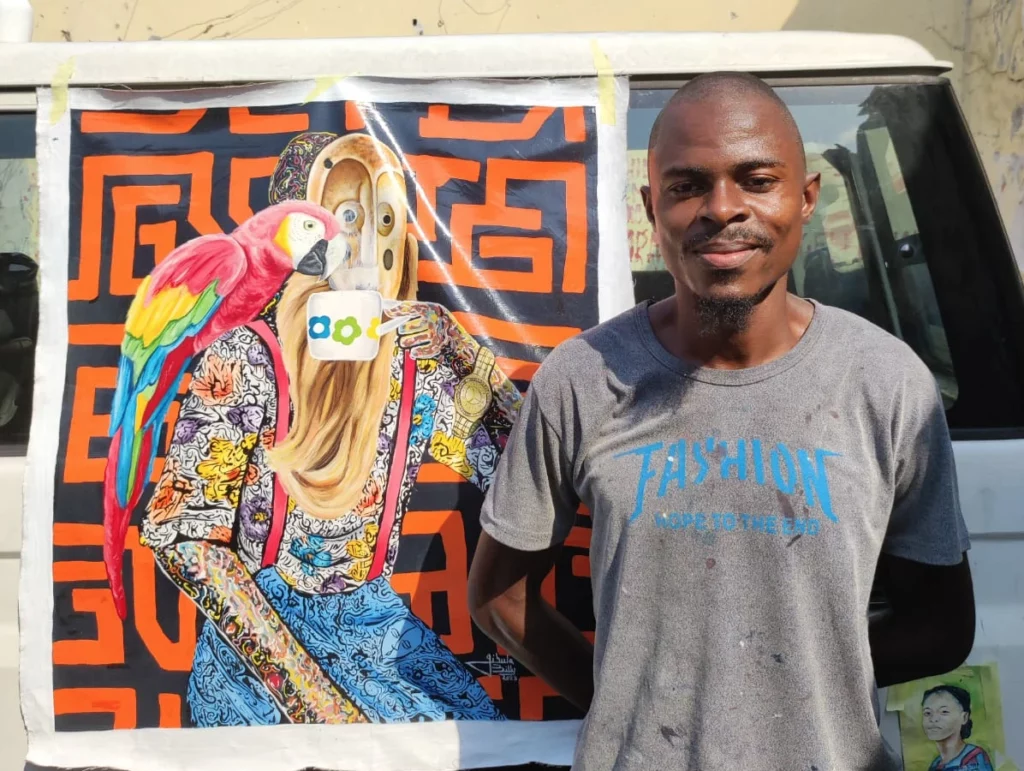
Billy: Hello, I am Billy Giboula, a painter of Congolese origin, born in Kinshasa in 1995. I have drawn since my childhood on papers. At 11 years old, I started painting on walls of commercial buildings, and also drawing copies of famous posters and comics. Through this vast experience, I have gained a deep understanding of how colors interact and blend and learned to create harmonious and aesthetically pleasing color palettes. Then I started to frequent the painter Jean Claude Lofenia, who became my mentor. After many years of dedicated practice and experimentation, under the supervision of maitre Lofenia, I have discovered what techniques, colors, and compositions resonate with me most deeply, and I have perfected these skills to create a unique body of work that is immediately recognizable as mine. It is incredibly gratifying to have developed a signature style that sets my art apart from others and makes it truly my own.
kitokongo: How did you meet your mentor?
Billy: It happened on the street, actually. I was sitting drawing a sapper monkey on paper, and suddenly this famous Kinshasa painter stopped and watched me working. After finishing my drawing, he invited me to work with him in his studio. This was around 2011, if I’m not mistaken.
kitokongo: How do you explain this passion for drawing since the age of 11?
Billy: Drawing has always been a joy for me. Ever since I was a kid, I found happiness in drawing. But at that age, I didn’t dream of being an artist, I dreamed of being a basketball player [Laugh].
Drawing has always been a joy for me. Ever since I was a kid, I found happiness in drawing.
kitokongo: From basketball player to painter. Who inspired you to pursue painting?
Billy: The fun I had drawing was greater than playing basketball. I was also fortunate to meet established artists who encouraged me to continue with drawing. At times, a small compliment on one of my drawings made me want to become an artist again.
Exploring the Creative Process
kitokongo: That was the first part to get to know you a little bit, to see how you became an artist. Now we want to get to know Billy, the artist. So you’re going to start by telling us about your creative process. What inspires you? How do you choose your subjects? And how do you approach your work?
Billy: I often get inspired by nature. So when I see nature, it inspires me a lot. And also with the culture of masks, I like masks a lot. Their stories, culture, and beauty fascinate and intrigue me at the same time. That’s why I chose to integrate the mask in my works. With the aim also to sensitize my audience. You know, in the Congo, there have been many conflicts and tribal wars, and unfortunately, this still persists. By blending various elements from different tribes into a single painting, like in this one featuring Kuba motifs in the background from the Lubas people and a mask from the Pende people, we create a captivating piece of art that can be appreciated by all tribes involved. This artistic fusion serves as a statement, reminding us that we can accomplish incredible things when we work together. It’s a message of peace and love, emphasizing that, in the end, we aren’t that different after all.
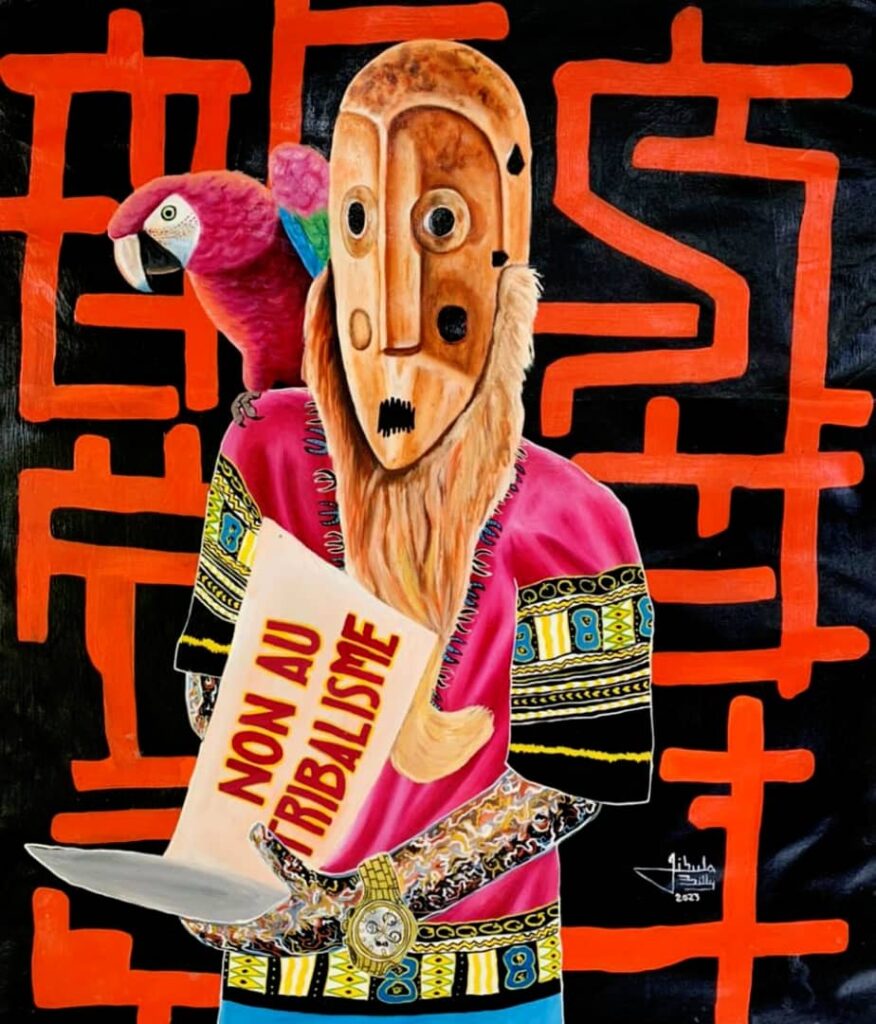
By blending various elements from different tribes into a single painting…we create a captivating piece of art that can be appreciated by all tribes involved…It’s a message of peace and love, emphasizing that, in the end, we aren’t that different after all.
kitokongo: How did your style evolve with time?
Billy: Oh, my style has changed quite a bit over time! In the beginning, my master’s teachings really shaped my work. I was just focused on learning the basics and getting a grip on the techniques. Later on, I started experimenting more. I studied other artists and found inspiration everywhere. That helped me figure out what I liked and what I was good at. It was when I met art critics that they encouraged me to find my own style, explaining to me that there were already artists who worked in the same way as my mentor. They made me realize that discovering my own artistic identity would be a challenging journey, but it was an essential step for me to genuinely express myself through my art. So I left my master’s studio to create my own. This allowed me to experiment a bit more freely. Even though the subjects were familiar, I used bright and unique colors to bring them to life. This exploration helped me find my own artistic style, which has helped my work stand out.

… discovering my own artistic identity would be a challenging journey, but it was an essential step for me to genuinely express myself through my art.
Billy picked up then one of his paintings and began to explain the meaning behind the lines and colors within the characters.
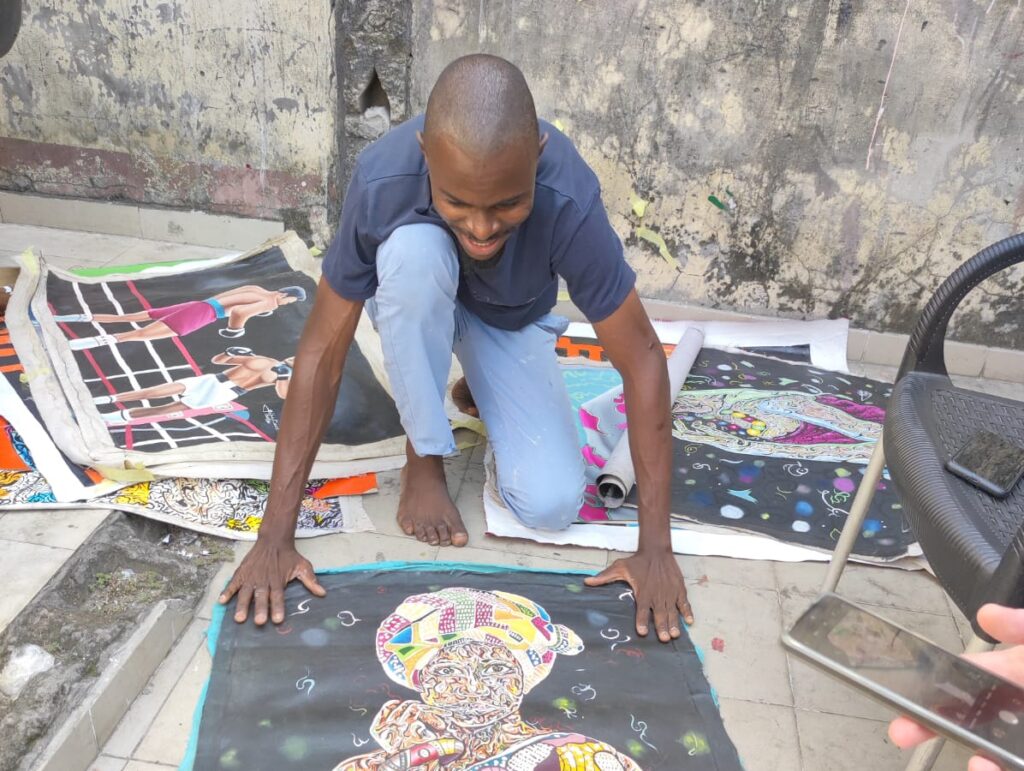
Billy: You know, when I created this artwork, I chose to paint the background in black to really capture that feeling of despair. But at the same time, I wanted to show the hope that’s always there inside us, fighting to break free. That’s the purpose behind the dynamic lines within her, sometimes even extending beyond her body. I’ve also woven in hidden messages, like the word “Kimia” which means peace in Lingala. For me, it’s all about capturing the constant struggle between despair and hope, and I’m so passionate about bringing that to life in every piece I create.
kitokongo: Along with these colorful characters, birds, parrots, roosters, and other animals always seem to be present in your paintings. What do they represent? What is their meaning? And why are they present in almost all your works?
Billy: Birds are a sign of waking up. A happy waking up, no matter how the night was. Fo instance, look at this painting, the theme is waking up. This character is sick. The mask that you see represents the illness. It is a Pende mask. Often at night, when one is sick, there is no way to move or get up. But during the day, when it’s light, you have to get up and do what you can to get better. So it’s the bird that is a symbol of waking up. This is actually my preferred artwork.
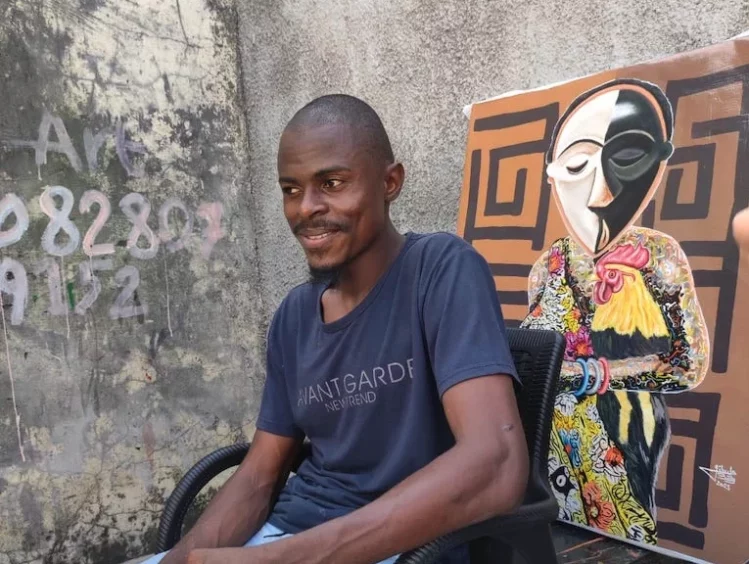
Addressing the Challenges of the Congolese Art Scene
In the final segment of the interview, we requested that Billy demonstrate his technique and approach to painting. He obliged and began working on a new canvas. As soon as his brush made contact with the surface, his facial expression transformed entirely. It was evident that the process brought him immense happiness and joy, radiating from every brushstroke.
kitokongo: As an artist in DR Congo, what do you feel is missing or lacking in the art scene?
Billy: The main issue is visibility. It seems like visibility doesn’t extend far enough. Often, gallery owners prefer to work with well-established artists—those who already have a reputation. This leaves emerging artists without the opportunity to gain exposure and recognition. Visibility is crucial to an artist’s success, so we find ourselves caught in a never-ending cycle. If you’re not famous, you don’t get visibility, and you can’t gain visibility because you’re not famous.
kitokongo: That’s precisely the issue we’ve recognized at Kitokongo, and it’s something we’re committed to changing. Kitokongo is dedicated to promoting underrepresented artists and artisans. Our platform is designed for talented individuals like you who may lack the connections needed for promotion elsewhere. Our mission is to support and elevate emerging artists, and we take this responsibility very seriously.
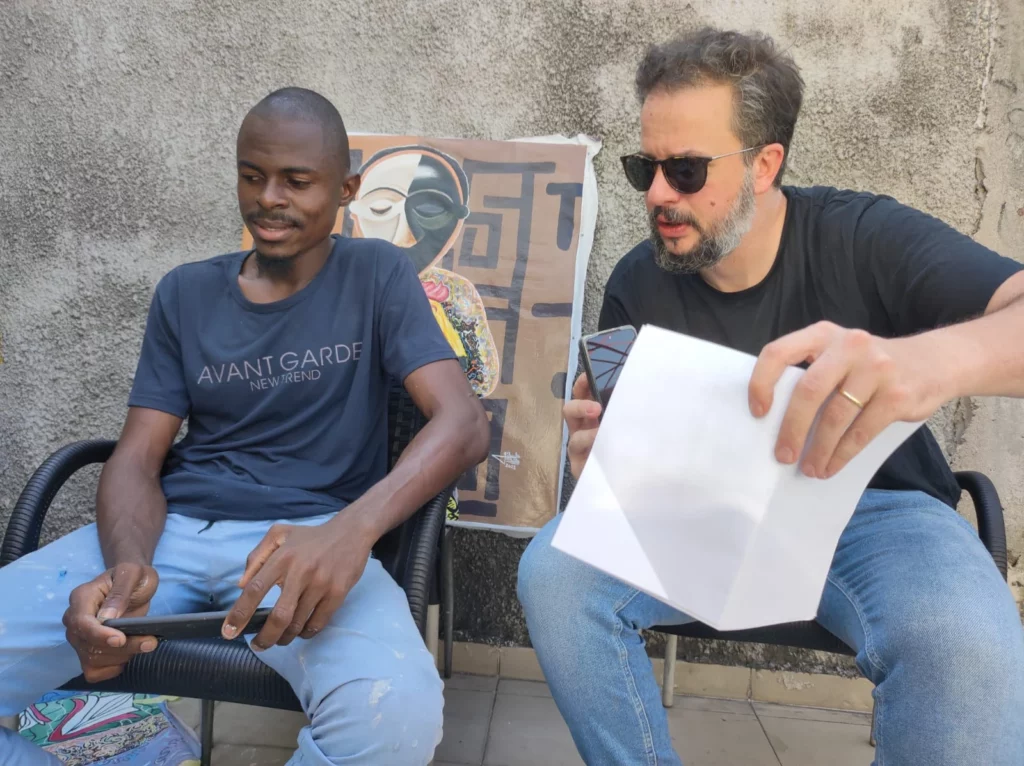
Kitokongo is dedicated to promoting underrepresented artists and artisans…Our mission is to support and elevate emerging artists, and we take this responsibility very seriously.
kitokongo: How do you see your role as an artist in Congolese society today?
Billy: In my artistic process, I always come back to themes of hope and love. I believe in the power of art to inspire hope, because the future has so much more to offer. Despite the difficulties artists face, there are always unexpected surprises and opportunities. We should wake up every day with renewed hope for a better day, no matter how challenging the night was. You never know what might happen—perhaps you’ll encounter someone who encourages you with kind words or even buys one of your artworks. In fact, many of my characters are artists themselves, like in this picture where the bird is holding a paintbrush in its beak. These are actually self-portraits.
kitokongo: I wasn’t aware of that. It’s great to learn this, and many things make sense now. When you mentioned the daily struggle earlier, you were referring to yourself.
Billy: Yes, both myself and my fellow artists. Being an artist isn’t easy, especially without opportunities to showcase our talents. Beyond that, my art also carries a message of peace and tolerance, in light of the tribal conflicts we face in DR Congo.
kitokongo: Do you have any advice for young artists just starting out? Are there any common mistakes to avoid or things they could do better?
Billy: One issue I see with young artists is that they often rush their work. They want to finish their pieces quickly and then exhibit or show them to others. My advice is to slow down and put in the extra effort to make each painting truly special. Remember, a piece of art is never really finished—it’s always evolving, with new elements being added. So, take your time when creating your artwork and focus on the details.
My advice is to slow down and put in the extra effort to make each painting truly special…So, take your time when creating your artwork and focus on the details.
kitokongo: Thank you, Billy, for this insightful interview. Your passion and dedication to your art, as well as your willingness to share your experiences, are truly inspiring. We look forward to following your continued artistic journey and witnessing the positive impact you’ll undoubtedly have on the Congolese art scene and beyond.
Conclusion
In our exclusive interview with talented painter Billy Gibula, we delved into his journey as an artist, his creative process, and the challenges he faces as an emerging artist in DR Congo. Billy’s passion for his work and commitment to spreading messages of hope, love, and unity through his art make him an inspiring figure in the Congolese art community. As we wrapped up our conversation, it became clear that Billy’s dedication to his craft and his determination to overcome obstacles will undoubtedly lead him to success in the art world.
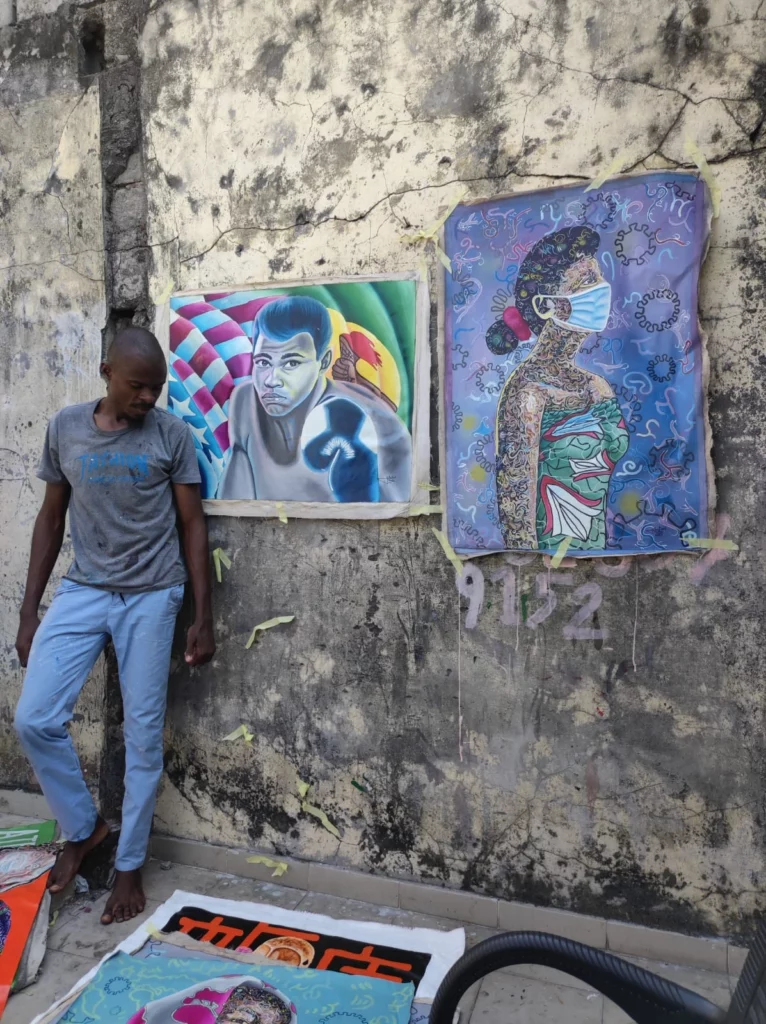
We would like to thank Billy once more for inviting us into his atelier and sharing his story with us. We hope that his experiences and insights will inspire other emerging artists to persevere and create meaningful art that reflects their unique perspectives.
Explore More
If you enjoyed this interview and want to learn more about other talented artists, be sure to check out other interviews and features on our blog. To stay updated on Billy’s work and the latest from the Congolese art scene, follow Kitokongo on social media.
Share your thoughts: We would love to hear your thoughts on this interview and your experiences with art in your own community. Leave a comment below, and let’s continue the conversation!
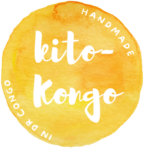
Comments